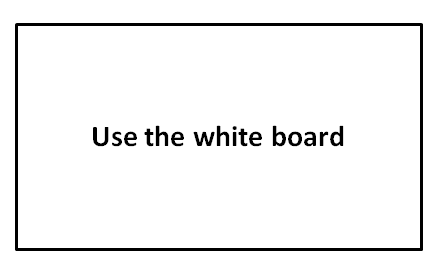Who does not love using the whiteboard?
It makes the experience creative, tactile, interactive, and open-ended. It’s a running joke with my teams that I will take any opportunity to pickup a dry-erase pen and head towards the whiteboard – like a moth to a night light. I actually have a 8 ft one in my personal home. Geek.

When the client takes the discussion in a different direction
I used the white board in two separate meetings this week to good effect. No matter how much we prepare, pre-wire the audience, think through the deliverables, there is a chance the client goes “off-script”. You have to be ready to re-trench, re-set the conversation, and re-start.
Whiteboard = neutral place
In the first meeting, folks expressed doubt in our hypothesis. In fact a few participants went into elaborate reasons why it would not work. It’s touchy because if you are not careful, a mob mentality can quickly ensue. The white board can be a refuge to organize thoughts and slow the discussion down.
White board = peace offering
It’s important to acknowledge what is being said. Don’t be the ugly consultant who says yes to placate the client, then forgets everything. There is the cynical consulting adage that says, “Repeat what the client said, and they will think you are a genius”. There is a lot of truth there. Write down what the client says.
Whiteboard = brainstorm
We are all kids at heart. It’s fun to innovate, and put ideas on the board. We all want to be team players. We want to be heard. 1) I wrote down the reasons why it wouldn’t work 2) then wrote down the reasons why it was important to come up with alternatives. From there, we “brainstormed” answers.
One of the initial detractors, perked up and pitched in, “It might not work, but what about. . . .” Then the next person replied, “Well, I would be willing to . . . ” Not exactly a fire of ideas, but a few sparks. At that point, I was happy to see the mood shift.
White board = outline
Once you have the ideas up there, it’s time to start summarizing the results and take on the role of the conversation architect. Don’t be afraid to circle the key points, number the items #1, #2, #3. Keep the pace and drive the conversation, until there is synthesis. Don’t present data, but drive it to a conclusion.
As usual, it’s important to structure the problem, and put it into buckets for easier decision making. We are in the idea grouping business. Buckets, I tell you, buckets.
Whiteboard = meeting minutes
Ironically, writing things down make it seem more permanent. Once it’s on paper or on the white board, there’s an implicit understanding that we agree with what is there. It serves as a form of meeting minutes.
Without the flexibility to shift and pivot the discussion, both meetings were headed towards an impasse. One of my team mates noted, “I am glad we had a white board here, was able to turn those two meetings around.” Completely agree. Every room needs a white board and the flexibility to re-orient the conversation. As Jim Collins says, we have to be prepared AND flexible. We need to be logical AND empathetic.

Great post! I’m a big fan of white boards too. For me, it’s a great way to clear my mind in times a blank sheet of paper won’t do.
We completely agree on that. Thanks for reading.